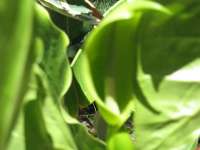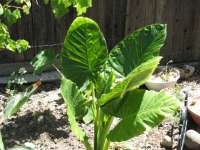 IAS on Facebook IAS on Facebook
 IAS on Instagram IAS on Instagram

|

IAS Aroid Quasi Forum
About Aroid-L
This is a continuously updated archive of the Aroid-L mailing list in a forum format - not an actual Forum. If you want to post, you will still need to register for the Aroid-L mailing list and send your postings by e-mail for moderation in the normal way.
|
ID needed
|
From: Don Martinson llmen at execpc.com> on 2000.02.02 at 15:49:01(4039)
Hi everyone,
I just returned from a trip to Tahiti and Moorea. My exploration time was
limited, but in addition to the all-present Colocasia and Xanthosoma, I
happened upon what is presumably an Amorphophallus species. It resembles
A. konjac except that it has noticable tubercles on the petiole, there are
numerous (well, 3) leaves present at the same time, and the leaf surface is
more glossy.
I've asked Les to put them on the Aroid ID Web Site, but in the meantime,
you can view them at:
http://www.execpc.com/~llmen/mooreamorpho1.jpg note tubercles on petiole
http://www.execpc.com/~llmen/mooreamorpho2.jpg note multiple petioles
http://www.execpc.com/~llmen/mooreamorpho3.jpg note shiny leaf surface
Suggestions anyone?
Don Martinson
| +More |
Milwaukee, Wisconsin
Mailto:llmen@execpc.com
|
|
From: "Alan Galloway" alan at unity.ncsu.edu> on 2000.02.02 at 17:27:43(4041)
On Feb 2, 9:50am, Don Martinson wrote:
> Subject: ID needed
> I happened upon what is presumably an Amorphophallus species. It resembles
> A. konjac except that it has noticable tubercles on the petiole, there are
> numerous (well, 3) leaves present at the same time, and the leaf surface is
> more glossy.
>
> I've asked Les to put them on the Aroid ID Web Site, but in the meantime,
> you can view them at:
>
> http://www.execpc.com/~llmen/mooreamorpho1.jpg note tubercles on petiole
> http://www.execpc.com/~llmen/mooreamorpho2.jpg note multiple petioles
> http://www.execpc.com/~llmen/mooreamorpho3.jpg note shiny leaf surface
>
> Suggestions anyone?
>
Don,
Sure looks like A. paeoniifolius to me.
Alan
| +More |
--
--------------------------------------------------------------------
Alan Galloway alan_galloway@ncsu.edu
Computing Services, Information Technology
Campus Box 7109 http://www4.ncsu.edu/~alan
North Carolina State University (phone) 919-515-5483
Raleigh, NC 27695-7109 (fax) 919-515-3787
|
|
From: Laufle at aol.com on 2000.02.02 at 19:20:04(4042)
Hi,
I live in LaCrosse, and I'm new to the world of arisaema (I hope I spelled
that correctly!). I suscribed to the message boards of something-or-other,
and I get the letters from people like you. Most of the info is over my
head, but I'm learning!
I was wondering how long you've been studying these types of plants, how you
cultivate them in Wisconsin, and how you bacame interested in them in the
first place.
| +More |
Thank you,
Sheri
|
|
From: Krzysztof Kozminski kk at netgate.net> on 2000.02.02 at 19:39:10(4043)
On Wed, 2 Feb 2000, Don Martinson wrote:
> Hi everyone,
>
> I just returned from a trip to Tahiti and Moorea. My exploration time was
> limited, but in addition to the all-present Colocasia and Xanthosoma, I
> happened upon what is presumably an Amorphophallus species. It resembles
> A. konjac except that it has noticable tubercles on the petiole, there are
> numerous (well, 3) leaves present at the same time, and the leaf surface is
> more glossy.
| +More |
>
> I've asked Les to put them on the Aroid ID Web Site, but in the meantime,
> you can view them at:
>
> http://www.execpc.com/~llmen/mooreamorpho1.jpg note tubercles on petiole
> http://www.execpc.com/~llmen/mooreamorpho2.jpg note multiple petioles
> http://www.execpc.com/~llmen/mooreamorpho3.jpg note shiny leaf surface
>
> Suggestions anyone?
Looks like A.paeoniifolius to me. I think these are just bumps, not
tubercles. Compare to
http://u1.netgate.net/~kk/Araceae/Amorphophallus/paeoniifolius.html
KK
====================
"Microsoft is to software what McDonalds is to gourmet cooking"
Krzysztof Kozminski
kk@netgate.net
http://u1.netgate.net/~kk/
|
|
From: "Hetterscheid, W." Hetter at Plantscope.nl> on 2000.02.04 at 15:23:45(4046)
Dear Don,
It is Amorphophallus paeoniifolius. Near-unique in the genus for its rough
petioles (others with that: opertus, scaber, koratensis).
Cheers,
Wilbert
| +More |
> -----Oorspronkelijk bericht-----
> Van: Don Martinson [mailto:llmen@execpc.com]
> Verzonden: woensdag 2 februari 2000 16:49
> Aan: Multiple recipients of list AROID-L
> Onderwerp: ID needed
>
>
> Hi everyone,
>
> I just returned from a trip to Tahiti and Moorea. My
> exploration time was
> limited, but in addition to the all-present Colocasia and
> Xanthosoma, I
> happened upon what is presumably an Amorphophallus species.
> It resembles
> A. konjac except that it has noticable tubercles on the
> petiole, there are
> numerous (well, 3) leaves present at the same time, and the
> leaf surface is
> more glossy.
>
> I've asked Les to put them on the Aroid ID Web Site, but in
> the meantime,
> you can view them at:
>
http://www.execpc.com/~llmen/mooreamorpho1.jpg note tubercles on
petiole
http://www.execpc.com/~llmen/mooreamorpho2.jpg note multiple petioles
http://www.execpc.com/~llmen/mooreamorpho3.jpg note shiny leaf surface
Suggestions anyone?
Don Martinson
Milwaukee, Wisconsin
Mailto:llmen@execpc.com
|
| |
|
From: "Christopher Rogers" <crogers at ecoanalysts.com> on 2008.09.12 at 12:06:17(18505)




Hiyer!
Looks like Alocasia gageana bywhat I can see of the inflorescences. I have attached pictures of one of myspecimens for comparison. This species is a good temperate Alocasia, and growswell out doors where the temperature does not drop below freezing very often (morningfrosts one or two months a year).
Here we can have the temperaturedrop below freezing for a week or two at a time, and my plants just go dormant,lose most of their leaves, and look lousy until late spring. They seem toprefer bright shade with either morning or evening direct sun, and a fairamount of humidity during the growing season. Outdoors I have grown them to twometers in height with leaves around a meter in length. In my greenhouse thegrowth is far more rapid, with the leaves a bit larger.
This plant is easily confusedwith A. macrorhiza (in our area macrorhiza rarely gets more than two meters inheight unless in a greenhouse) , which has a yellow spathe that reflexes awayfrom the spadix, and A. odora, which has an erect yellow spathe, as opposed tothe green spathe on gageana.
Happy days,
Christopher
| HTML +More | |
D. Christopher Rogers
Senior Invertebrate Ecologist/Taxonomist
((,///////////======= |
|
From: Sheldon Hatheway <sfhatheway at yahoo.com> on 2008.09.12 at 15:11:33(18509)
Cyndi,
Looks like an Alocasia - perhaps macrorhiza?
Sheldon
| HTML +More |
----- Original Message ----
From: "Cyndikrall@aol.com"
To: aroid-l@gizmoworks.com
Sent: Thursday, September 11, 2008 4:57:35 PM
Subject: [Aroid-l] ID needed
Does anyone know what this plant is? Found it at a local garden center. Sorry for the blurry pic of the bloom!
Cyndi
Psssst...Have you heard the news? There's a new fashion blog, plus the latest fall trends and hair styles at StyleList.com.
--0-2053837448-1221232293=:32634----============== 40160194423908293=� |
|
From: Cyndikrall at aol.com on 2008.09.12 at 21:58:00(18519)
Thank you, Christopher! I do believe you are right! I got the plant out at a pond nursery over in Sonoma. The mother plant was a monster, just gorgeous. I knew I had to have it, lol. I'll mulch it real well over the winter, since I might be just a little colder than you.
Cyndi
| HTML +More | |
In a message dated 9/12/2008 9:15:01 A.M. Pacific Daylight Time, crogers@ecoanalysts.com writes:
Hiyer!
Looks like Alocasia gageana by what I can see of the inflorescences. I have attached pictures of one of my specimens for comparison. This species is a good temperate Alocasia, and grows well out doors where the temperature does not drop below freezing very often (morning frosts one or two months a year).
Here we can have the temperature drop below freezing for a week or two at a time, and my plants just go dormant, lose most of their leaves, and look lousy until late spring. They seem to prefer bright shade with either morning or evening direct sun, and a fair amount of humidity during the growing season. Outdoors I have grown them to two meters in height with leaves around a meter in length. In my greenhouse the growth is far more rapid, with the leaves a bit larger.
This plant is easily confused with A. macrorhiza (in our area macrorhiza rarely gets more than two meters in height unless in a greenhouse) , which has a yellow spathe that reflexes away from the spadix, and A. odora, which has an erect yellow spathe, as opposed to the green spathe on gageana.
Happy days,
Christopher
D. Christopher Rogers
Senior Invertebrate Ecologist/ Taxonomist
((,///////////======= |
|
From: Cyndikrall at aol.com on 2008.09.12 at 21:59:24(18520)
Thanks, Sheldon...I think Christopher has it right, from what I can tell by googling some pics. The venation is a lot more pronounced than A. macrorhiza.
Cyndi
| HTML +More | |
In a message dated 9/12/2008 9:15:04 A.M. Pacific Daylight Time, sfhatheway@yahoo.com writes:
Cyndi,
Looks like an Alocasia - perhaps macrorhiza?
Sheldon
----- Original Message ----
From: "Cyndikrall@aol.com"
To: aroid-l@gizmoworks.com
Sent: Thursday, September 11, 2008 4:57:35 PM
Subject: [Aroid-l] ID needed
Does anyone know what this plant is? Found it at a local garden center. Sorry for the blurry pic of the bloom!
Cyndi
Psssst...Have you heard the news? There's a new fashion blog, plus the latest fall trends and hair
Psssst...Have you heard the news? There's a new fashion blog, plus the latest fall trends and hair styles at StyleList.com.
-------------------------------1221256764----==============V00436293427650831=� |
| |
Note: this is a very old post, so no reply function is available.
|
|








